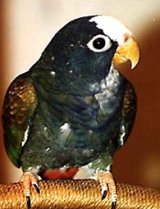
Some of the more common skin and feather disorders are discussed below. Others, such as feather cysts, baldness, brown hypertrophy of the cere, polyfollicles, and knemidokoptes mites were covered in a previous article Common Skin and Feather Disorders Part I.
Myialges nudus
A second type of mite that can infect birds is Myialges nudus. This mite most commonly is found on captive grey cheek parakeets, but also has been found on other species of birds. Unlike Cnemitocoptes, discussed in the previous article, Myialges causes severe itching. Infected birds become very debilitated, lose feathers, suffer weight loss and develop red, scaly, thickened skin. If untreated, death occurs within several months. These mites are microscopic, with all stages found in tunnels in the bird’s skin. Flies and lice may be involved in transferring these mites to other birds. Diagnosis is by clinical signs and identification of the mites in scrapings from the skin. Treatment is with Ivermectin.
Xanthomas
Xanthomas are yellow to orange thickened, dimpled patches of skin composed of lipids and cholesterol accumulation. The pectoral (breast area), thighs, and wing tips are the most frequently affected. Xanthomas are often invasive as well destructive. These are most prevalent in budgies, cockatiels and cockatoos. The cause of xanthomas is unknown at the present time, but high fat diets may be contributory.
Ulcerative Dermatitis
Ulcerative dermatitis refers to red, oozing, ulcerated skin. The affected area is often swollen and the bird often has an elevated white blood cell count, indicative of infection. Ulcerative dermatitis can be associated with previous trauma, wounds, diabetes and certain intestinal parasites. The bird picks at its skin, creating the ulcers. These sores are frequently itchy, causing the bird to pick at the area more. Bacterial and/or fungal infections may occur secondary to the lesions. Treatment consists of trying to determine the underlying cause, cleaning the wound, using an appropriate topical and systemic antibiotic, and placing a collar to allow the wound to heal. Lovebirds, cockatiels, grey cheeks, amazons and cockatoos are most often affected.
Uropygial Gland/Preen Gland
The uropygial gland is found on the back at the base of the tail in certain species of birds – such as African grey parrots, cockatiels, canaries, budgies, conures and waterfowl. Amazons do not possess this gland. It’s secretions are spread on the feathers by grooming and are important in waterproofing. Impactions, abscesses and tumors of this gland may occur.
Bumble foot (pododermatitis)
Bumble foot refers to an inflammatory or degenerative condition of the foot. In mild cases, redness or swelling on the plantar (bottom) surface of the foot, while severe bumble foot involves deep-seated abscesses and infection of the bone. This condition is most prevalent in heavy bodied birds such as amazons, raptors and waterfowl. Many factors are thought to be involved – including poor nutritional status, improper perches, improper environment and trauma to the foot. Early bumble foot can be treated successfully while severe cases involving bone carry a poor prognosis.
Additional disorders such as feather cysts, baldness, brown hypertrophy of the cere, polyfollicles, and knemidokoptes mites were covered in a previous article Common Skin and Feather Disorders Part I.

